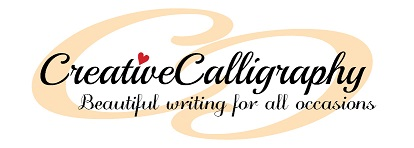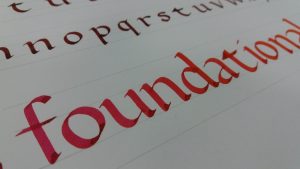Why I love Pilot Parallel Pens
Pilot Parallel Pens are my favourite writing tools when it comes to calligraphy practice and demonstrations.
I was introduced to them by a fellow student on a calligraphy course I attended about four years ago and they’ve been a staple part of my kit ever since.
The cartridge pens come in four nib sizes – 1.5mm, 2.4mm, 3.8mm and 6mm – with colour coded caps.
I’ve only ever had the first three but have long coveted the thickest nib.
Pilot Parallel Pens from The Pen Company
The Pen Company was kind enough to send me a ‘blue pen’ to help complete my collection and I’ve been giving it a whirl at my workshops.
I like to use a good, thick nib when demonstrating so people peering over my shoulder can see how the nib is angled and how it’s moving across the paper.
I usually go for the 3.8mm nib for this, but the 6mm is better again, as it helps create a much larger letter.
It just means I go through more paper!
Paper and ink test
Like all good quality calligraphy pens, Pilot Parallel Pens work best on thicker, smoother paper.
I tend to use Rhodia pads or Inacopia Elite Colour Plus 100g/m2, although the ink doesn’t bleed on Daley Rowney layout paper, which is just 45g/m2.
It does take the ink a little longer to dry than, say, the Manuscript Pen Company cartridge pens that I use as an entry-level pen for workshop participants.
Speaking of cartridges, there are 12 ink colours cartridges available for the Pilot Parallel Pen, as well as an ink converter for use with bottled inks.
Gradated lettering
By using two Pilot Parallel Pens, each with different coloured ink cartridges, you can achieve beautiful gradated letter.
I haven’t tried this myself yet, but I’ve achieved the same ombre effect by simply changing cartridges in the past!
It’s worth noting that when the pen is held with the Pilot logo facing upwards, the corner of the nib can be used for regular writing.
I found this particularly useful when learning Gothicised Italic script, as it requires you to come up onto the corner of the nib, which was much easier to do with a Pilot Parallel Pen.
Parallel Plate Structure
One of the main reasons these pens have become a staple part of my kit is that I’ve never had a problem with ink flow.
I don’t have to shake the pen to get it started or worry about the nib unit getting clogged up.
This is down to the ‘Parallel Plate Structure’ of the nib – two parallel plates feeding a continuous flow of ink from the cartridge in the pen barrel.
This also helps achieve sharper lines, making everything very precise. And I like precise!
What you get in a Pilot Parallel Pen set
The pens, when sold separately, also come with a lovely instruction booklet, including three calligraphy alphabet exemplars, accessories such as a nib cleaner and pipette for cleaning the pen unit and care instructions.
If you’d like to give your calligraphy a boost with a Pilot Parallel Pen, I have a 3.8mm pen set (RRP £13.99) to give away, courtesy of The Pen Company.
It includes a Pilot Parallel Pen (cap, pen unit, barrel), two ink cartridges, pipette, nib cleaner and instructions and care guide.
To enter, click the Rafflecopter link below.




I write by hand with a lightweight zebra pen. I’ve not tried calligraphy since I was a teenager and it does interest me as a hobby although it looks hard to do. Having the right pen must help!
I like using the japanese super soft grip mechanical pens
I love a proper ink pen – have a lovely Waterman pen x
I used to love writing with a fountain pen as a teenager, I really love stationary and pens and always feel your writing becomes even more beautiful with a lovely quality pen to write with.
I use an Uniball Signo pen for writing. I used to use a fountain pen and spend hours practising but since having children I didn’t have the time. I would love to start again, calligraphy is such a beautiful art.
I use a Uniball Signo pen for writing. I used to practice writing with a fountain pen when I was younger but then I had children and unfortunately didnt have time to learn. I would love to practice again as calligraphy is a beautiful art.
For regular writing, I like using a Pilot VPrecise V5 rolling ball extra fine!
Regular writing it has to be a bic pen though I keep loosing them!
I like to use a fountain pen for writing x
Are the pilot parallel pens suitable for lefthanders?
Hi Marjorie,
Broad-edged pens for left-handers usually have an oblique-cut nib, which the Pilot Parallel Pen doesn’t have, so I think you might find it a bit tricky to use, particularly if you’re an over-writer.
Angela